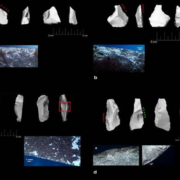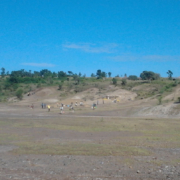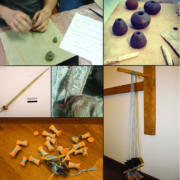Qesem Cave (AYCC), Revadim, Jaljulia (Acheulean)
Site excavation director: A.Gopher, R.Barkai, Department of Archaeology, Tel Aviv University TAU
LTFAPA project Chipped stone tools use-wear and residues analysis funded by MAECI and by International Agreement Project of Speinza University
Qesem Cave and the open sites of Revadim and Jajiulia are located near Tel Aviv. Revadim and Jajiulia are two Late Acheulean sites reach in flint industry characterized by bifaces and by flakes, small flakes, tools, and small tools. At Revadim, the taphonomic processes allowed to preserve numerous remains of fauna that comprise mammals of different sizes and megafuana. Both sites are really promising for the analysis of use-wear and residues. As far as Revadim concerns, various publication documented the use of the lithic industry to carry out different types of activities among which butchering seems to prevail.
The intriguing question under study is if the items of small size, that are abundant at Revadim, may have been involved in the processing of megafauna. To explore the relationship small tools-megafauna a PhD project by TAU with the collaboration with LTFAPA Sapienza (PhD candidate F.Marinelli) is in progress and is starting to produce interesting results now under in publication. Qesem Cave is an extraordinary well-preserved site, consisting of sediments some 10m deep, all assigned to the Acheulo Yabrudian Cultural Complex (AYCC). The flint industry is blade-dominated in the Amudian sequence while scraper-dominated in the Yabrudian sequence. Many burnt bones and flint items were found at Qesem Cave. In addition, ash was found in the cave’s sediments. It appears that the use of fire was common throughout the sequence, including a repeatedly used, superimposed central hearth dated to ca. 300 ka.
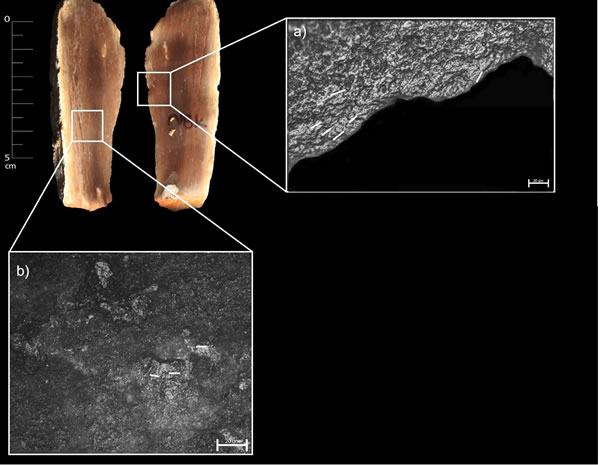
The faunal assemblage includes Dama mesopotamica (dominates the assemblage), Bos, Equus, Sus, Testudo, Cervus. The absence of all body parts indicates that carcasses were first processed outside of the site and only selected parts were brought to the cave. Furthermore, cut marks were abundant indicating butchering on-site. Use-wear and residues analyses reviled that at Qesem Cave hominins used blades, Quina and demi-Quina scrapers and small items from recycling to process animal and plant materials. There is no doubt that these categories of tools were used as specialized tools-kit during butchering. In particular, Quina scrapers were used as specialized toolkit to process fresh, semi-dry and dried hide. New extraordinary data, published in 2019 and 2020, documented: 1 – the use of recycled old spheroids macro-lithic tools for the breakage of bones, probably to exploit their marrow, 2 – a complex behaviour of manipulation of animal and plant (tubers) food consisting in roasting with hot wooden ash and/or also preserving food and non-food matters using cold ash.
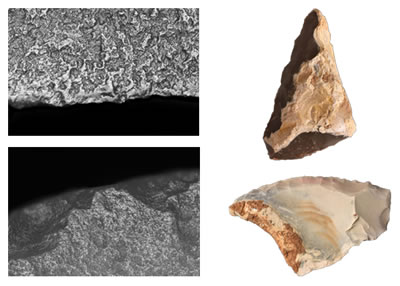
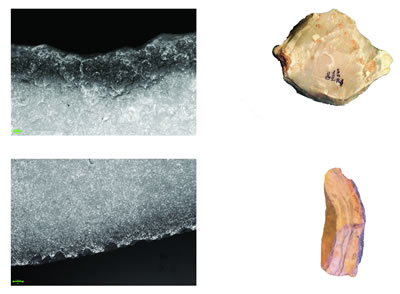
References
C.Lemorini, M.C.Stiner, A.Gopher, R.Shmelmitz, R.Barkai (2006), Use-wear analysis of an Amudian laminar assemblage from the Acheuleo-Yabrudian of Qesem Cave, Israel, Journal of Archaeological Science 33: 921-934. https://doi..org/10.1016/j.jas.2005.10.019
Shahack-Gross R., Berna F., Karkanas P., Lemorini C., Gopher A., Barkai R. (2014), Evidence for the repeated use of a central hearth at Middle Pleistocene (300 ky ago) Qesem Cave, Israel, Journal of Archaeological Science 44, pp. 12-21, doi:10.1016/j.jas.2013.11.015
N., Solodenko; A., Zupancich; S., Nunziante Cesaro; O., Marder; Lemorini, Cristina; R., Barkai 2015. Fat Residue and Use-Wear Found on Acheulian Biface and Scraper Associated with Butchered Elephant Remains at the Site of Revadim, Israel. pp.1-17. PlosOne. doi:10.1371/journal.pone.0118572
Lemorini C., Venditti F., Assaf E., Parush Y., Barkai R., Gopher A. (2015), The function of recycled lithic items at late Lower Paleolithic QesemCave, Israel: An overview of the use-wear data, Quaternary International 361, pp. 103-112, doi:10.1016/j.quaint.2014.07.032
Barkai R., Lemorini C., Vaquero M. (2015), The origins of recycling: a Paleolithic perspective, Quaternary International 361, pp. 1-3, doi:10.1016/j.quaint.2014.12.044
Lemorini C., Bourguignon L., Zupancich1 A., Gopher A., Barkai R. (2016), A scraper’s life history: Morpho-techno-functional and use-wear analysis of Quina and demi-Quina scrapers from Qesem Cave, Israel, Quaternary International 398, pp. 86-93, doi:10.1016/j.quaint.2015.05.013
Zupancich A., Lemorini C., Gopher A., Barkai R. (2016), On Quina and demi-Quina scraper handling: Preliminary results from the late Lower Paleolithic site of Qesem Cave, Israel, Quaternary International 398, pp. 94-102, doi:10.1016/j.quaint.2015.10.101
Zupancich A., Nunziante-Cesaro S., Blasco R., Rosell J., Cristiani E., Venditti F., Lemorini C., Barkai R. Gopher A. 2016 Early evidence of stone tool use in bone working activities at Qesem Cave, Israel, Scientific Reports 6. http//doi:10.1038/srep37686.
Venditti F., Cristiani E., Nunziante-Cesaro3 S. Agam A., Lemorini C., Barkai R. 2019 Animal residues found on tiny Lower paleolithic tools reveal their use in butchery, Scientific Reports. https://doi.org/10.1038/s41598-019-49650-8
Assaf E, Caricola I, Gopher A, Rosell J, Blasco R, Bar O, Zilberman, E., Lemorini, C., et al. (2020) Shaped stone balls were used for bone marrow extraction at Lower Paleolithic Qesem Cave, Israel. PLoS ONE 15(4): e0230972. https://doi.org/10.1371/journal.pone.0230972
Lemorini C., Cristiani E., Nunziante Cesaro S., Venditti F., Zupancich A., Gopher A. The use of ash at Late Lower Paleolithic Qesem Cave, Israel—An integrated study of use-wear and residue analysis, PlosOne (2020). https://doi.org/10.1371/journal.pone.0237502
Mathias, C.; Lemorini, C.; Marinelli, F.; Sanchez-Dehesa Galan, S.; Shemer, M.; Barkai, R.. (2023 Bulb retouchers half a million years ago: New evidence from late Acheulean Jaljulia, Israel, JOURNAL OF ARCHAEOLOGICAL SCIENCE: REPORTS. – ISSN 2352-409X. – 47:(2023), p. 103821. [10.1016/j.jasrep.2022.103821]
Venosa Basin, Italy
Site excavation director: M.H. Moncel, UMR 7194 HNHP (MNHN-CNRS-UPVD), Département Homme et Environnement, Muséum National d’Histoire Naturelle
LTFAPA project: use-wear and residues analyses of chipped stone tools
The site of Notarchico is the most ancient Acheulean site of Italy, one of the most ancient in Europe, dating around 700 Kya. The site consists of an imponent 7 m-thick sequence of fluvial sediments including various archaeological levels excavated during the ‘80s-’90s of the last century. Recently, new excavations were promoted by M.H. Moncel and her team. LTFAPA lab. is part of this team and has in charge the use-wear analysis of the lithic industry in collaboration with B. Hardy (Kenyon College, USA) who carries out the residues analysis. The recent paper published in Scientific Reports of Nature, documents the preservation of use-wear and residues on small flakes and small tools that were used for different activities, apparently without some prevailing activity. It is worth mentioning that plant and, especially, wood working are well represented, testifying activities not only related to food processing.
References
Moncel M.H, , Santagata, C., Pereira, A., Nomade, S., Voinchet, P., Bahain,J.-J., Daujeard, C., Curci, A., Lemorini, C. et al. “The origin of early Acheulean expansion in Europe 700 ka ago: new findings at Notarchirico (Italy). Scientific Reports 10, 13802 (2020). https://doi.org/10.1038/s41598-020-68617-8
Moncel, MH., Lemorini, C., Eramo, G. et al. A taphonomic and spatial distribution study of the new levels of the middle Pleistocene site of Notarchirico (670–695 ka, Venosa, Basilicata, Italy). Archaeol Anthropol Sci 15, 106 (2023). https://doi.org/10.1007/s12520-023-01809-1
The LTFAPA project at the site of Notarchirico is now part of the ERC Advanced Research Project LATEUROPE (PI M.H.Moncel) https://lateurope.cnrs.fr/
Lower Paleolithic, Oldowan sites, Kenya
http://humanorigins.si.edu/research/east-african-research/
Sites excavation director: T.W.Plummer, Queens College, CUNY & NYCEP, NY, USA.
LTFAPA project: use-wear and residues analyses of chipped stone tools and macro-lithic tools of the Oldowan sites of Kanjera South, Nyayanga, Sari River.
The Homa Peninsula is a region located insouthwestern Kenya, reach in anthropic evidences of Early Stone Age. Three Oldowan sites, ranging from 2.600 – 2 Mya, are currently under study: the fully excavated site of Kanjera South and the two sites of Nyayanga and Sari River. The intensive survey and excavation of the archeological occurrences of the Homa Peninsula for more than two decades and the related analyses, allowed to obtain a detailed picture of the local paleoenvironment at that time, of the fauna exploitation, of the lithic raw material exploitation and the knapping techniques that hominins carried out to make lithic tools. Lithic raw material consists of a great variety of rocks (igneous, sedimentary, metamorphic and metasomatised), the 28% of which are non-local and collected in stream and river conglomerates no closer than 10-13 km from Kanjera South and Nyayanga. The core production modes change in relation to the exploited raw material. At Nyayanga, besides the chipped stone tools, macro-lithic tools, made of the same imported raw material, are present.
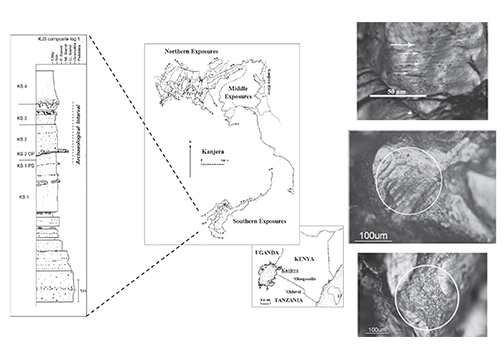
The great state of preservation of the lithic industry, extremely rare in so ancient contexts and probably caused by the fast deposition of the artifacts, allowed to set up a research project of use-wear analysis and residue analyses in collaboration with the National Museum of Nairobi.
Amazing data resulted from the use-wear analysis were already published in 2014 and 2019. Quartz, quartzite, rhyolite and fenetized chipped stone tools from Kanjera South were used not only for butchering but also for cutting and processing a variety of plants as wood, herbaceous plants and tubers. These data shed new light on the behavior of so ancient hominins suggesting that they were strongly familiar with plants exploitation.
The research project is going on with the analysis of the chipped stone tools and the macro-lithic tools of Nyayanga that are revealing extraordinary results now under publication.
References
Lemorini C., Plummer T.W., Braun D.R., Crittenden A.N., Ditchfield P.W., Bishop L.C., Hertel F., Oliver J.S., Marlowe F.W., Schoeninger M.J., Richard Potts R. (2014), Old stones’ song: Use-wear experiments and analysis of the Oldowan quartz and quartzite assemblage from Kanjera South (Kenya), Journal of Human Evolution, pp. 10-25. https://doi:10.1016/j.jhevol.2014.03.002
Lemorini C., Bishop L. C., Plummer T. W., Braun D. R., Ditchfield P W., Oliver J. S. 2019 Old stones’ song—second verse: use-wear analysis of rhyolite and fenetized andesite artifacts from the Oldowan lithic industry of Kanjera South, Kenya, Archaeological and Anthropological Sciences, volume 11, 9, pp 4729–4754. https://doi.org/10.1007/s12520-019-00800-z
Bishop, Laura C.; Plummer, Thomas W.; Braun, David R.; Ditchfield, Peter W.; Goble Early, Emily; Hertel, Fritz; Lemorini, Cristina; et al. (2022) Fauna and Paleoenvironments of the Homa Peninsula, Western Kenya Chapter 29 African Paleoecology and Human Evolution , pp. 360 – 375. https://doi.org/10.1017/9781139696470.029
Thomas W. Plummer, James S. Oliver, Emma M. Finestone, Peter W. Ditchfield, Laura C. Bishop, Scott A. Blumenthal, Cristina Lemorini, Isabella Caricola ….and and Richard Potts (2023) Expanded geographic distribution and dietary strategies of the earliest Oldowan hominins and Paranthropus, Science}, 379}, 663, 561-566}. https://doi.org/10.1126/science.abo7452.
Residues Analysis
Lemorini C., Nunziante Cesaro S. (eds.), (2014), An integration of use-wear and residues analysis for the identification of the function of archaeological stone tools, BAR (I.S.), Oxford, pp. 63-76. doi: http//:10.30861/9781407312880
Nucara A., Nunziante-Cesaro S., Venditti F., Lemorini C. A multivariate analysis for enhancing the interpretation of infrared spectra of plant residues on lithic artefacts. J. Archaeol. Sci. Rep. (2020). https://doi.org/10.1016/j.jasrep.2020.102526.
Traces analysis on spinning and weaving archeological tool-kits
Laurito R., Lemorini C., Perilli A. (2014), Cap. 10, Making Textiles at Arslantepe, Turkey, in the 4th and 3rd Millennia BC. Archaeological Data and Experimental Archaeology. In: C.Breniquet, C.Michel (eds.), Wool economy in the ancient Near East and the Aegean. From the beginnings of sheep husbandry to institutional textile industry, Ancient Textile Series, vol. 17, Oxbow Books, Oxford, pp. 151-168.
Forte, V., Lemorini, C. 2017. Traceological analyses applied to textile implements: an assessment of the method through the case study of the 1st millennium BC ceramic tools in Central Italy. ORIGINI XL, pp.165-182. ISBN10: 977047468000817001
Galli, M., Coletti, F., Lemorini, C., Mitschke, S., 2018 The textile culture at Pompeii project, In Maria Stella Busana, Margarita Gleba, Francesco Meoand Anna Rosa Tricomi (a cura di) Textiles and Dyes in the Mediterranean Economy and Society , Proceedings of the VIth International Symposium on Textiles and Dyes in the Ancient Mediterranean World (Padova – Este – Altino, Italy 17 – 20 October 2016) Libros Portico, Valencia.
Forte V., Coletti F., Ciccarelli E., Lemorini C. The Contribution of Experimental Archaeology in Addressing the Analysis of Residues on Spindle-Whorls, EXARC Journal Issue 2019/4.
https://exarc.net/issue-2019-4/ea/contribution-ea-spindle-whorls


